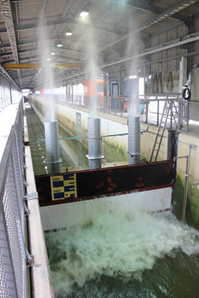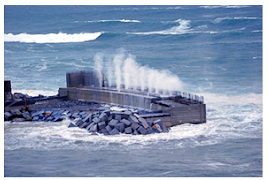

 The main idea is to start with the numerical codes already developed at CENTEC, for sea-wave interaction with OWC devices and to extend them so that the device behavior in both regular and random wave conditions can be assessed and the impact of each of the chambers' resonant modes on sea-wave energy absorption is evaluated. Linear and non-linear models where the functioning of an impulse turbine is simulated are to be used, as well as the CFD software package OpenFOAM.
The main idea is to start with the numerical codes already developed at CENTEC, for sea-wave interaction with OWC devices and to extend them so that the device behavior in both regular and random wave conditions can be assessed and the impact of each of the chambers' resonant modes on sea-wave energy absorption is evaluated. Linear and non-linear models where the functioning of an impulse turbine is simulated are to be used, as well as the CFD software package OpenFOAM.In addition to the obvious solution of Mutriku, northern Spain, which makes sense for already existing structures, it will be analyzed the inclusion of these devices in new structures, especially in vertical breakwaters. An other innovative component of the project is the use of the dual chamber OWC. The relevance of the project lies on enabling the harvest of renewable energy, using this type of devices to create sheltered areas for port activities, and being driven by a potential deployment location on the Portuguese coast.

The novel devised OWC device will be designed to be attached to an existing breakwater located possibly in the Açores islands, in Madeira or in Sines port in Portugal. Hence, the project is being performed according to the following 5 tasks:
Task 1 - Wave Data Analysis: dominant environmental conditions are determined, for the selected zones, to provide an appropriate base for the basic design of the geometrical aspect of the device and an appropriate extreme wave data is also analyzed to be applied later in structural design of the device main elements;
Task 2 - Preliminary design and optimization of the geometrical configuration based on linear numerical modeling: the hydrodynamic model is developed to analyze the dual-chamber OWC device based on the boundary element method;
Task 3 - Prove of conceptual design by implementing advanced numerical techniques: the in-house non-linear boundary element code is adjusted to analyze the device performance and then the designed device is modeled and analyzed in the OpenFoam package in order to take into account viscous effects which may impose significant influences especially in the resonant modes;
Task 4 - Experimental validation: The model for the designed dual-chamber OWC is built and the experimental tests is carried out in the wave flume of the Laboratório Nacional de Engenharia Civil (LNEC). The obtained results from the experimental investigation are compared with the results achieved from all the numerical models and their degree of precision is investigated;
Task 5 - Structural Design and Analysis: the appropriate cross sections of the main structural elements are designed and their strength are evaluated by analyzing the model of the structure in the Finite Element commercial software.